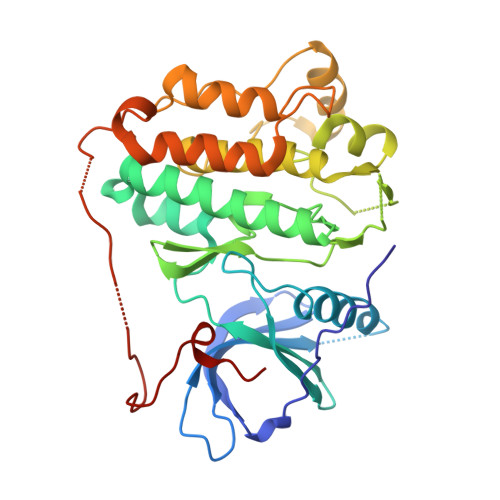Discovery of a Highly Potent and Broadly Effective Epidermal Growth Factor Receptor and HER2 Exon 20 Insertion Mutant Inhibitor.
Jang, J., Son, J., Park, E., Kosaka, T., Saxon, J.A., De Clercq, D.J.H., Choi, H.G., Tanizaki, J., Eck, M.J., Janne, P.A., Gray, N.S.(2018) Angew Chem Int Ed Engl 57: 11629-11633
- PubMed: 29978938
- DOI: https://doi.org/10.1002/anie.201805187
- Primary Citation of Related Structures:
6D8E - PubMed Abstract:
Exon 20 insertion (Ex20Ins) mutations are the third most prevalent epidermal growth factor receptor (EGFR) activating mutation and the most prevalent HER2 mutation in non-small cell lung cancer (NSCLC). Novel therapeutics for the patients with Ex20Ins mutations are urgently needed, due to their poor responses to the currently approved EGFR and HER2 inhibitors. Here we report the discovery of highly potent and broadly effective EGFR and HER2 Ex20Ins mutant inhibitors. The co-crystal structure of compound 1 b in complex with wild type EGFR clearly revealed an additional hydrophobic interaction of 4-fluorobenzene ring within a deep hydrophobic pocket, which has not been widely exploited in the development of EGFR and HER2 inhibitors. As compared with afatinib, compound 1 a exhibited superior inhibition of proliferation and signaling pathways in Ba/F3 cells harboring either EGFR or HER2 Ex20Ins mutations, and in the EGFR P772_H773insPNP patient-derived lung cancer cell line DFCI127. Our study identifies promising strategies for development of EGFR and HER2 Ex20Ins mutant inhibitors.
Organizational Affiliation:
Department of Cancer Biology, Dana-Farber Cancer Institute, Boston, MA, 02215, USA.















